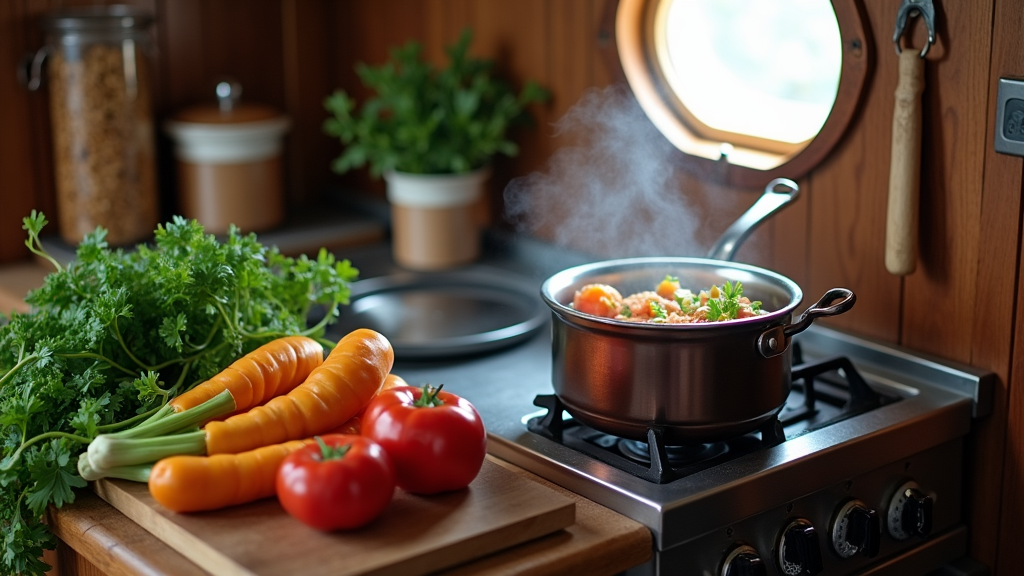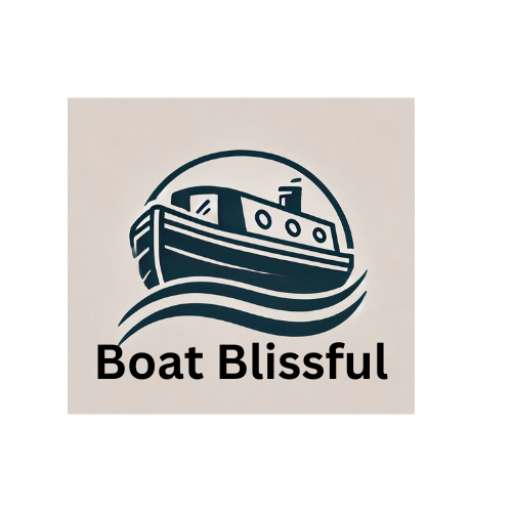One-Pot Meals Perfect For Narrowboat Kitchens
Narrowboat kitchens. These compact, quirky spaces floating along the canal bring some unique cooking challenges, especially if you’re craving a hot, comforting meal after a day on the water. With limited space, small cookers, and storage that requires Tetris level skills, I’ve learned the hard way that keeping meals simple, satisfying, and mess free is pretty handy. One pot meals have become my go-to, saving time and cutting down on washing up (a treasure when your sink is the size of a salad bowl).

Why One Pot Meals Work So Well on a Narrowboat
If you’ve ever tried prepping multiple pans in a narrowboat galley, you’ll know how quickly things get cramped. Even basic tasks like draining pasta can turn into an adventure if your only countertop does double duty as both a chopping board and a drying rack.
One pot meals aren’t just about skipping hassle; they fit right into the slower pace of canal life. With just a gas hob or a cozy stove, dishes that don’t need lots of heat zones or complex techniques are my bread and butter. There’s less washing up, fewer ingredients tumbling to the floor, and the bonus of meals that get more delicious as they simmer gently.
Getting Started: Must Have Kitchen Kit for Canal Cooking
Equipping a narrowboat galley doesn’t have to be fancy, but a few sturdy bits of kit can really make life a lot easier:
- Sturdy Lidded Pot or Dutch Oven: Your main workhorse for stews, curries, pastas, and risottos. Cast iron or heavy stainless steel keeps heat steady, which helps when simmering on unpredictable boat stoves.
- Chopping Board: Choose one with a nonslip base since boats can rock at any time.
- Sharp Knife: A reliable chef’s knife saves you loads of effort, and you won’t regret the space it needs.
- Basic Utensils: A big spoon, a spatula, and tongs really cover nearly everything.
- Small Colander or Sieve: Grab one that nests inside your main pot to keep storage simple.
Cooking utensils with folding handles or stackable features are very helpful when storage is tight. It’s a great idea to pick up a heatproof mat so you can put hot pans straight onto the worksurface with no worries.
Narrowboat One Pot Recipe Inspiration
Here are some steady favorites I keep going back to. They’re great with store cupboard basics and whatever fresh bits I pick up along the towpath. Each one comes together in a single pot and leaves plenty of leftovers for another meal, which is key when you want to save on gas or water.
Vegetarian Canal Chili
Dump together beans, tinned tomatoes, chunky peppers, and sweetcorn for a hearty meal. Add chili powder and paprika, simmer for about 30 minutes, and you’re set. I usually toss in some rice for a filling, one stop dinner.
Sausage & Bean Stew
Brown some sausages in your pot, add a tin of mixed beans, a splash of stock, and carrots or celery if you’ve got them. Let it all bubble away and serve with crusty bread. Flavors get richer the longer it sits, so it’s a top choice for reheating on a chilly night.
Pasta alla Narrowboat
Pour in dry pasta, tinned tomatoes, water or stock, garlic, and whatever veg you have (frozen spinach is a hero) in your pot. Let everything simmer until the pasta is cooked and the sauce is thick—no extra saucepans needed. Sprinkle cheese over if you feel like treating yourself.
Simple Boat Curry
Diced potatoes, onions, a spoonful of curry paste, plus any lentils or chickpeas from the cupboard come together fast. A tin of coconut milk or just water gives a creamy sauce. Eat as is, or with flatbreads warmed on the pot’s lid for extra comfort.
Smart Shopping and Prep Tips for One Pot Success
Shopping for a narrowboat means thinking small and smart. Here’s what consistently works best for me:
- Buy in small amounts: Stick to what you’ll cook in a few days. Canalside shops can get pricey, but local markets are a fun way to track down fresh produce.
- Stock up on longlife basics: Beans, tinned tomatoes, rice, pasta, and spices are real stars when you’re far from a supermarket.
- Cook bigger batches if you can: If fridge space allows, making extra saves time and gas later in the week.
- Prep everything at once: Doing all your chopping at the start keeps things neat and helps avoid spills in the tight space.
Adapting Recipes for Narrowboat Life
Complicated recipes or those with loads of odd ingredients rarely make sense afloat. I stick with flexible, forgiving meals you can mess about with depending on what’s still fresh or stashed in a cupboard. Here are a few tricks I use all the time:
- Go low and slow: Boat cookers aren’t always super powerful. Gentle simmering brings out more flavor and keeps you from burning stuff, even with uneven heat.
- Make the most of lid time: If something needs to simmer covered for a while, use that time to clean down the galley, slice bread, or make a cup of tea.
- Swap ingredients on the fly: Out of potatoes? Canned chickpeas will do. No fresh greens? Tinned peas or sweetcorn are perfect backup.
Common Narrowboat Cooking Hurdles (and Solutions!)
Galley cooking has its bumps, but there’s always a boating fix that’ll get you back on track:
Low Fuel or Gas
If you’re running low on gas canisters, there’s pressure to make fuel last. One pot meals that simmer with the lid on really help. Stews and curries are brilliant here—keep the pot sealed so you don’t waste a drop of heat.
No Fridge or a Tiny Coolbox
Fresh food doesn’t last long on a boat. Tinned beans, cured meats, and root veggies survive ages in the cupboard, and longlife or powdered milk usually works as a swap for fresh. Make smaller batches so you don’t lose food if the fridge lets you down.
Bumpy Rides
Things slide around when another boat goes by or in rough weather. I keep breakables stashed safely and hold pans with a towel if things get rocking. If you’ve got the power, a slow cooker is useful for set and forget meals, but a heavy pot with a lid is just about as good.
Next Level Tips for Easy Galley Cooking
After you get the basics down, a few little tips will really step up your narrowboat cooking game:
Batch prepping saves time: Chop extra veggies or cook a double batch of grains for later and mealtimes will fly by.
Get creative with leftovers: Yesterday’s stew? Try it as pie filling or pop it onto toast. I love mashing up leftover spuds and veggies for breakfast cakes too.
Pressure cookers are game changers: Got the power? A compact stovetop pressure cooker speeds meals along and makes beans or lentils a breeze. They’re a tad bulky but worth checking out, especially if you cook pulses often.
Best Kitchen Staples to Keep Onboard
- Longgrain rice, pearl barley, or couscous
- Tinned tomatoes, beans, and lentils
- Pasta (short shapes work best in a cramped pot)
- Stock cubes or bouillon powder
- Salt, pepper, garlic granules, dried chili flakes
- Small bottles of olive oil and vinegar
- Cheese, smoked or dried sausages (these last longer out of the fridge)
These food basics are cheap, versatile, and hang around in the cupboard for ages. Almost any one pot meal is possible with just a couple small extras added in.
Frequently Asked Questions
Here are some questions I get from new boaters, visiting friends, or anyone amazed that dinner comes together in such a tiny space:
Question: Can I use a slow cooker on a narrowboat?
Answer: If your boat has solar panels or a marina hook up, you’ll likely be able to use a small slow cooker, but gas or solid fuel is easier for most folks who are on the move.
Question: What’s the easiest meal to make on a boat?
Answer: My favorites are vegetable chili or easy one pot pasta—simple, flavorful, and nearly no washing up.
Question: How do you save on fuel when cooking?
Answer: Simmer instead of boiling, cook in bulk, and always cook with a lid to keep heat in. Doing food prep up front saves more time and gas too.
Enjoying Canal Cooking, One Pot at a Time
Narrowboat kitchens may be small, but a batch of flavorful, hearty one pot meals can make them feel much larger. Picking recipes that make sense for your gear, space, and the slower pace of canal living makes cooking on board more fun and less hassle. Next time you’re out on the cut, give a one pot meal a shot. You may just stumble upon how stress free and rewarding boat cooking can be.
